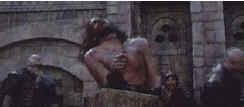 Low Christology does not exalt the Divinity of Jesus over his humanity. It opens itself to the reality of Jesus' human experience. His immediacy and connection with our experience is reflected in architecture and art.
Low Christology does not exalt the Divinity of Jesus over his humanity. It opens itself to the reality of Jesus' human experience. His immediacy and connection with our experience is reflected in architecture and art.We see Low Christology reflected in the church architectures which bring the altar down toward the people and even into their center, as it were. It tends to have a more semi-circular design with the activities around the altar being brought
 physically and psychologically closer to the people. The circular-style seating also promotes much more of a feeling of community and connection with fellow worshippers. The warmth of this sort of arrangement contrasts the austerity of the high cathedrals of Europe.
physically and psychologically closer to the people. The circular-style seating also promotes much more of a feeling of community and connection with fellow worshippers. The warmth of this sort of arrangement contrasts the austerity of the high cathedrals of Europe. In art, we find depictions of the temptations and suffering of Christ looking like suffering. No longer does the art look like mild discomfort or a slightly bad afternoon, but the agony described in the gospels.
In art, we find depictions of the temptations and suffering of Christ looking like suffering. No longer does the art look like mild discomfort or a slightly bad afternoon, but the agony described in the gospels.I recently watched the 6-hour Jesus of Nazareth movie from the 1970s, and was blown away by how the actor's facial expressions are almost robotic or trancelike. This represents the ideology of the directors or producers - Jesus could barely crack a smile. He was remote and disconnected from his disciples. He was blank or sober in expression much of the time. I guess he was busy being Divine.
Contrast this with the made-for-TV movie entitled "Jesus" released in 2000. Jesus smiles, dances, laughs, is shown chanting in the temple with the "law" on his forehead according to tradition, teases his cousin John, feels insecure, loves and goofs
 around with his disciples, and plays with the children.
around with his disciples, and plays with the children.In Gethsemane He claws at the grass, and some the temptation is depicted as a struggle to stand strong in his path as Satan offers ways out of the coming torture and assures Jesus that His efforts will be in vain. I really cared about this Jesus and felt conflicted and torn by "Satan's" arguments.
The production sought to bring us into Jesus' experience, and Him into ours.
I didn't cry when the 1970's movie Jesus was crucified. It was an awful intellectual exercise to watch, but I had no personal attachment to the figure. But in the 2000 movie, I bawled my eyes out. I had LOVED this Jesus. I was devastated. A precious, beloved mentor was being unjustly tortured and killed before our eyes. It seems to me that this emotional response to Jesus' crucifixion is far more appropriate than a merely intellectual dismay and distaste.
While the Gibson movie certainly didn't shy from showing incredibly hideous torture in all it's physicality, it failed to generate in me a feeling of connection to the figure on the screen before the torture started. Again,
 I spent most of the movie in a state of horrified fascination---in an intellectual and analytical response---critiquing the scholarship and almost finding a morbid humour in how "horrible" advanced to insufferably hideous, to ridiculously horrendous. The only times I wept were when humanity, in efforts to support and comfort Jesus, broke through the relentless torture. Otherwise, it didn't bring me into my heart at all. I stayed in my head, just to survive.
I spent most of the movie in a state of horrified fascination---in an intellectual and analytical response---critiquing the scholarship and almost finding a morbid humour in how "horrible" advanced to insufferably hideous, to ridiculously horrendous. The only times I wept were when humanity, in efforts to support and comfort Jesus, broke through the relentless torture. Otherwise, it didn't bring me into my heart at all. I stayed in my head, just to survive.So, what is the thing about High Christology and Low Christology? Is Low Christology "better" than high Christology?
I don't think so. I think separation of Human and Divine is harmful, either way you slice it.
If we make Jesus too human, he becomes our buddy, our yes-man, or our "sweet" friend who is essentially a powerless wuss.
We need to really get it in our very blood that Christ is Divine and human, Human and divine. They don't cancel each other out. They aren't mutually exclusive.
I think this is hard for us. I think we tend to be out of balance with it, and it takes a lifetime to "get-it-together" or see that they are One.
God with us.
GOD with us.
God WITH us.
God with us.
No comments:
Post a Comment